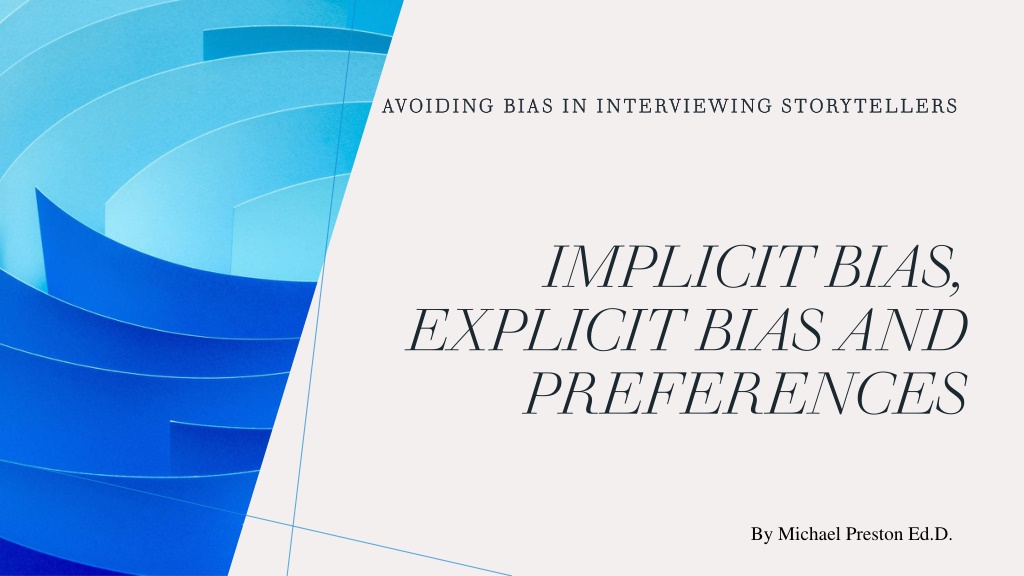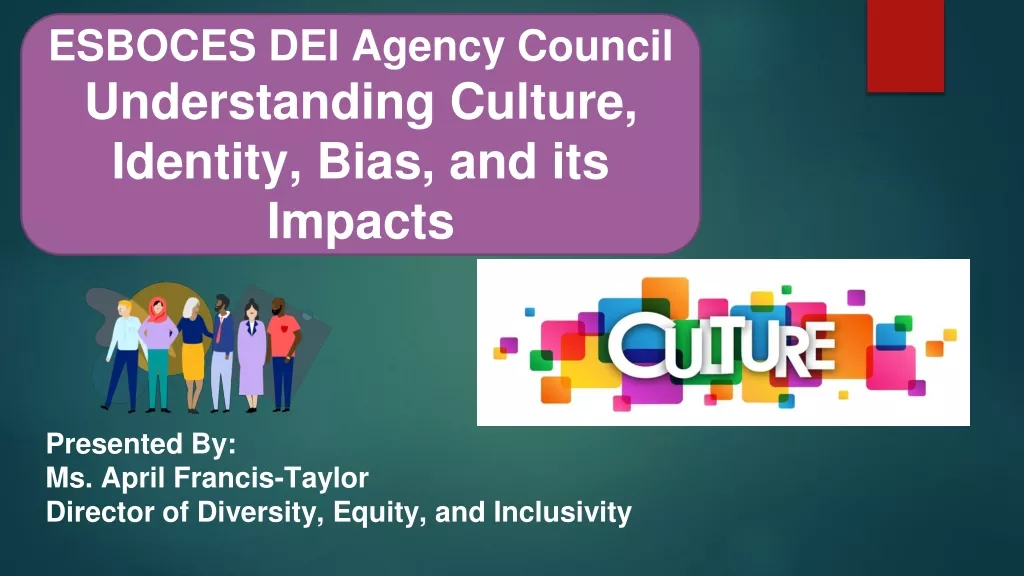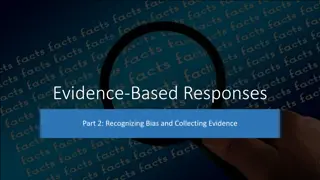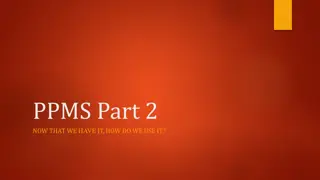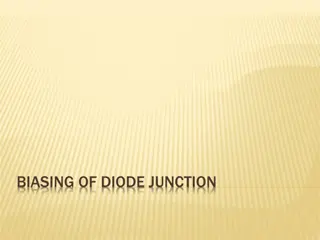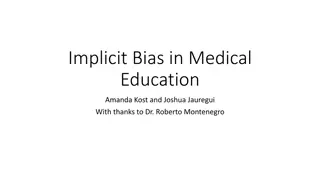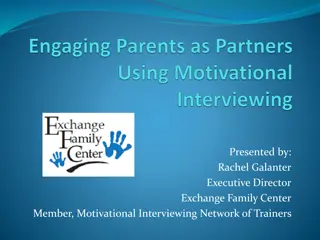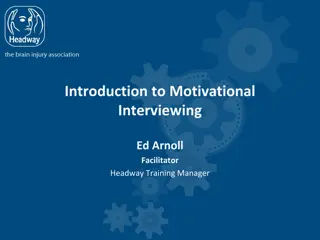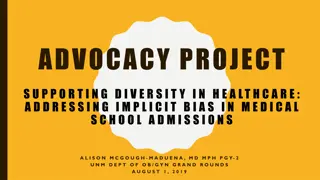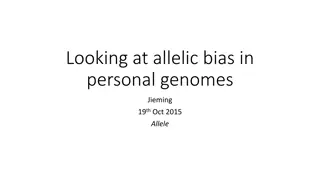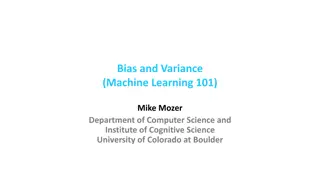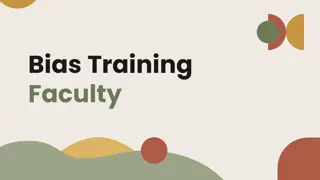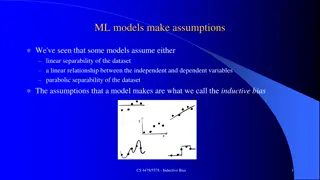Understanding and Overcoming Bias in Interviewing
Bias in interviewing can arise from implicit and explicit prejudices, impacting perceptions and interactions with interviewees. Implicit biases are unconscious, while explicit biases are deliberate. Recognizing and addressing biases is essential to conduct fair and effective interviews. Examples illustrate how biases can influence judgments, emphasizing the importance of challenging stereotypes and breaking free from preconceived notions.
Download Presentation

Please find below an Image/Link to download the presentation.
The content on the website is provided AS IS for your information and personal use only. It may not be sold, licensed, or shared on other websites without obtaining consent from the author. Download presentation by click this link. If you encounter any issues during the download, it is possible that the publisher has removed the file from their server.
E N D
Presentation Transcript
AVOIDING BIAS IN INTERVIEWING STORYTELLERS AVOIDING BIAS IN INTERVIEWING STORYTELLERS IMPLICIT BIAS, EXPLICIT BIAS AND PREFERENCES By Michael Preston Ed.D.
WHAT IS BIAS? Bias is prejudice against a person or group of people when compared to others. These biases are usually based on prior attitudes, first impressions, or socially constructed stereotypes. Example: Bias among sports fans A family member attends MSU and Ole Miss is the instate rival of MSU. Since they attend MSU, we are an MSU family. If we see someone wearing Ole Miss apparel, we decide we would not like them just based on what they are wearing. We make an unfair opinion on them based solely on them being an Ole Miss fan. This is bias. We are biased toward MSU so we decide we don t like the Ole Miss fan. We could get along well under other circumstances, but to find out, we must remove our bias. Good natured rivalries are different from bias and are okay!
TYPES OF BIAS Implicit Bias: Actions based on prejudice and stereotypes without intending to do so. This is an unconscious act or thought; however, it does show a familiar association. Explicit Bias: Actions based on prejudice and stereotypes intending to do so. In this type people are very aware of their bias.
EXAMPLES OF EXPLICIT BIAS Most of us are aware of explicit bias. Traditionally these include sexism, racism, sexual orientation and ageism. Can you think of any that are missing? Some people show explicit bias towards senior citizens. People with explicit bias toward seniors feel they are too old to think or move quickly, unable to lift items, do not understand technology, and are not patient with children. Between FGP and RSVP, VCI has hundreds of volunteers, ranging from ages 55-100. In what ways do you break the stereotypes focused on seniors?
Remember, implicit bias is an unconscious bias. We don t realize we are doing this. For example, Nicole is an introvert. In social settings, she tends to stand to the side and out of the way. Separating herself made people feel uncomfortable. They didn t know why it was uncomfortable and of all the things they considered, being an introvert was not one of them. Another example, in the form of riddle: A dad brings his son to the hospital after an accident. When the doctor in the ER sees the patient, the Dr. exclaims, I cannot operate on this boy, he is my son! . Who is the doctor? Find out on the next slide. EXAMPLES OF IMPLICIT BIAS
The Answer to the Riddle? The doctor is the boy s mom. Many who consider this riddle assumes the doctor is a male and thus neglect to solve the riddle. Reflection Questions: Have you ever realized you had an implicit bias based on learned gender schemas? Do your personal insecurities affect how you perceive others, such as when Nicole was not interacting with the group? Would you assume Nicole had a problem with you or your group, rather than struggling with her own inner issues?
WHY ARE WE DISCUSSING BIAS? Understanding bias allows us to recognize bias feeling in ourselves. We want storytellers and interviewer to have an open mind when they are working together to record history. Coming in with a preconceived bias based on the person, the topic or the questions will make for a tense situation and may not capture the story the way it was intended. We want this to be a pleasant experience for both the storyteller and the interviewer. You will be asked to leave feedback afterwards to help us improve where needed.
HOW DOES BIAS DIFFER FROM PREFERENCE? Preference, unlike bias, is something that is preferred by individuals. Some examples of preference are: characteristics you look for in a mate, a more desirable place to live or what kind of job you would enjoy doing.
HOW DO FIRST IMPRESSIONS FIT IN? First impressions are important as they are going to shape biases and preferences. Research shows that it takes under 7 seconds to make a first impression. First impressions can prove or refute explicit biases. All explicit biases that are refuted will help to challenge implicit biases. An example can be how quickly a server acknowledges you have been seated in their section of the restaurant affects how you feel if they are a good server.
HOW CAN YOU RECOGNIZE IMPLICIT BIAS? Remember Implicit Bias tends to be unconscious. We don t realize that we have the bias. It may be cultural or nurtured (how we were raised). Implicit Bias is not due to chance and so be able to recognize your attitude toward a person or people. An easy way to recognize implicit bias is if you encounter a person or group and feel uncomfortable, worried, unsure, or uneasy. This can be implicit bias. Example: When I left for college and went out in public, it would annoy me when people shuffled their feet instead of picking them up. One day I had to ask myself why it bothered me, and I realized it was because it bothered my mother. Once I recognized the reason, it didn t bother me anymore.
HOW BIASES AFFECT INTERACTIONS Biases, no matter their source, can impact interactions in several ways. The following are generally most prominent: Body Language Just as you may have a first impression, the subject will also have a first impression of you. Bias can impact body language and communicate negative feelings. Verbal Expression Bias can influence how you speak to others. You may speak with someone in flowery terms, or you may show a lack of respect in your word choices. Listening Skills You may show your bias by being easily distracted or otherwise not actively listening to the subject. Most people can tell when we are distracted, and it can be off- putting. Affinity Bias If your bias is positive it can result in assigning certain traits to the subject even if it is not justified. This can skew data and create false narratives.
HOW CAN YOU CHANGE BIASES? Changing biases is a challenge, but it can be done. For explicit biases we are already aware of our bias. To change we may need to understand why the bias is there and try to overcome by learning from others, reading more about bias, and increasing positive interactions. For implicit biases, it is more difficult as we may not realize the bias. If there is a situation that makes one uncomfortable or uneasy, it is important to ask ourselves why. Where is the discomfort coming from? Techniques to change implicit bias are on the next slide.
CHANGING IMPLICIT BIASES UCLA Vice Chancellor, Jerry Kang recommends the following to help recognize and replace implicit biases: Evaluate your mindset- Be humble (no one is better than anyone else), be mindful and be internally motivated to change. De-bias yourself- Biases can be molded and contradicted. Who are you surrounding yourself with, what media do you watch, what messages are you receiving? Decoupling- Break the link between bias and behavior. If your behavior is not favorable, then evaluate if there is bias there.
We would like to provide an activity. This is something just for you. ONE MINUTE ACTIVITY Think about (or write down) a time that you now recognize that you had an implicit bias toward a person or group, but it changed over time or through an interaction. What were the circumstances? How were you feeling? What were your thoughts in the beginning? What happened to change your mindset?
IN CONCLUSION Please remember we are interested in capturing stories and history from those who lived it. To make sure everyone is comfortable enough to share their story and converse with the interviewer, it is important to have non-biased interactions. Thank you for participating in our training session. If you have any questions, please contact your Volunteer Coordinator.
MORE INFORMATION If you would like more information on implicit bias, please visit these websites and articles: https://www.scientificamerican.com/article/how-to-think-about-implicit-bias/ https://www.vox.com/2014/12/26/7443979/racism-implicit-racial-bias https://equity.ucla.edu/know/implicit-bias/
REFERENCES Brownstein. (2019, July 31). Implicit bias. The Stanford Encyclopedia of Philosophy. https://plato.stanford.edu/entries/implicit-bias/ First Impressions. (n.d.). Retrieved from https://www.psychologytoday.com/us/basics/fir st-impressions Kang, J. (2016, Sept. 9). Lesson 6: Countermeasures [video]. YouTube. https://www.youtube.com/watch?v=RIOGenW u_iA&feature=youtu.be
